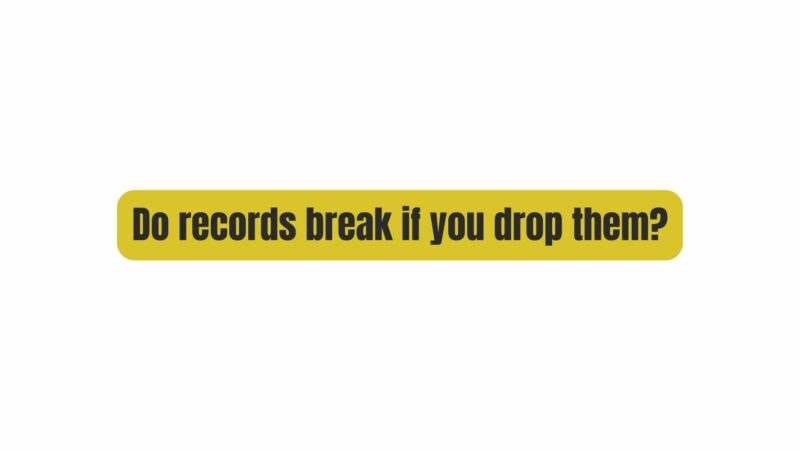Vinyl records, with their iconic grooved surfaces, have remained a symbol of music nostalgia for generations. Their analog charm and tactile engagement evoke a sense of reverence for music enthusiasts. However, a lingering concern among collectors and vinyl enthusiasts is whether records break if you drop them. In this comprehensive article, we will delve into the structural makeup of vinyl records, the potential consequences of dropping them, and best practices for handling records to ensure their longevity.
I. Understanding the Anatomy of Vinyl Records
Before addressing whether records break when dropped, it’s crucial to have a firm grasp of the fundamental components that make up a vinyl record:
- Vinyl Disc: The vinyl disc itself is the circular medium on which audio is recorded. It comes in various sizes, with the most common being the 12-inch LP (long-playing) and the 7-inch single.
- Grooves: The audio content is stored in the form of grooves that spiral from the outer edge of the record toward the center. These grooves are where the music is physically etched.
- Label: The center of the record features a label, typically displaying the album title, tracklist, and artist information.
- Dead Wax: The area between the last track’s groove and the label is known as the “dead wax.” This section typically contains no audio information.
II. The Vulnerability of Vinyl Records
Vinyl records are undeniably delicate, which contributes to the concern about their susceptibility to damage when dropped. Several factors make records more vulnerable to breakage or damage:
- Material Composition: Vinyl records are made of a relatively brittle material. They can shatter or crack upon impact.
- Thinness: Vinyl records are thin, which makes them less structurally robust compared to other materials.
- Groove Depth: The grooves on vinyl records are shallow and intricately etched, which means any damage to the surface can potentially affect playback quality.
- Weight Distribution: Vinyl records have a circular shape with an empty center, which can make them prone to breaking when force is applied unevenly.
Given these factors, it’s natural to be concerned about the fragility of vinyl records.
III. The Consequences of Dropping a Vinyl Record
Dropping a vinyl record can result in a range of consequences, some of which may affect the record’s playability and value:
- Surface Damage: The impact from a drop can cause surface scratches or scuffs, which can create audible pops and crackles during playback.
- Groove Damage: The grooves, where the audio information is stored, are particularly vulnerable to damage. Deep scratches or cracks in the grooves can result in skips or distortions during playback.
- Warping: A significant drop or impact can warp the record, causing it to become unplayable as it no longer sits flat on the turntable.
- Cracking or Shattering: In extreme cases, a vinyl record can crack or shatter upon impact, rendering it irreparable.
- Stylus Damage: If a dropped record causes significant damage to the grooves, it can also affect the turntable’s stylus, shortening its lifespan and potentially requiring replacement.
- Reduced Resale Value: For collectors, any damage to a vinyl record, including that caused by a drop, can significantly reduce its resale value.
IV. Best Practices for Handling Vinyl Records
To preserve the condition and playability of your vinyl records, it’s essential to adopt proper handling practices:
- Store Vertically: Keep records stored vertically, like books, to prevent warping. Use record storage crates or shelving designed for vinyl records.
- Handle with Clean Hands: Always wash and dry your hands thoroughly before handling records to avoid transferring oils, dirt, or debris onto the surface.
- Hold by the Edges: When handling records, hold them by the edges, not the playing surface. This minimizes the risk of inadvertently touching the grooves.
- Use Inner and Outer Sleeves: Invest in anti-static inner sleeves and outer jackets to protect your records from dust, scratches, and static electricity.
- Avoid Dropping or Bumping: Be extremely cautious when moving or transporting records. Avoid dropping or bumping them, as even minor impacts can lead to damage.
- Use a Quality Turntable: Use a high-quality turntable with a clean stylus to minimize wear and tear on the grooves.
- Properly Cue and Lower the Stylus: When cueing and lowering the stylus onto the record, do so gently and with care to avoid sudden drops.
- Clean Records Regularly: Clean your records regularly using a suitable record cleaning brush or machine to remove dust and debris.
V. The Vinyl Revival and Preservation
In recent years, vinyl records have experienced a resurgence in popularity, with renewed interest in analog audio quality and tangible music experiences. The revival of vinyl is driven by several factors:
- Audiophile Appeal: Audiophiles appreciate the warm, analog sound quality that vinyl records offer, distinguishing them from digital formats.
- Tangibility: Vinyl records provide a tactile and multisensory listening experience, from handling the record to cuing the stylus.
- Collectible Nature: Vinyl records, especially rare and limited editions, have gained value as collectibles, driving a thriving market.
- Nostalgia: Vinyl records evoke nostalgia for older generations and intrigue younger generations who may not have experienced the format firsthand.
- Album Artwork: The larger album artwork and physical presence of vinyl records contribute to their aesthetic appeal and visual impact.
As vinyl records continue to thrive, the preservation of their condition remains essential for collectors and enthusiasts.
VI. Conclusion
In the exploration of whether records break when dropped, we have considered the structural vulnerabilities of vinyl records, the potential consequences of mishandling, and the best practices for preserving these cherished musical artifacts. While vinyl records may be delicate, their enduring appeal transcends their fragility, as they offer a unique and tangible connection to the world of music.
So, the next time you handle a vinyl record, remember the delicate balance between fragility and resilience—a balance that underscores the enduring magic of vinyl and the commitment to preserving its legacy for generations to come.

